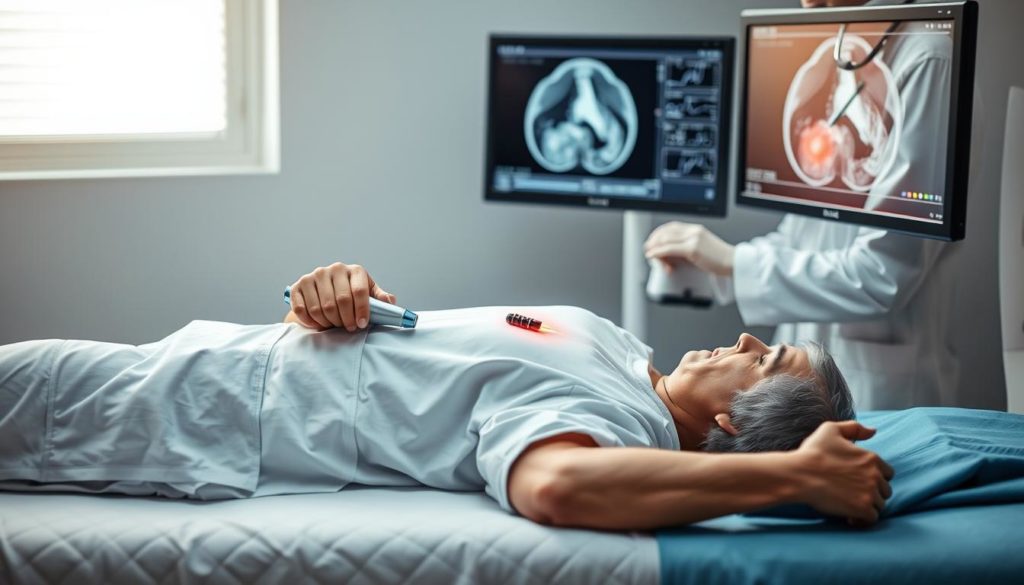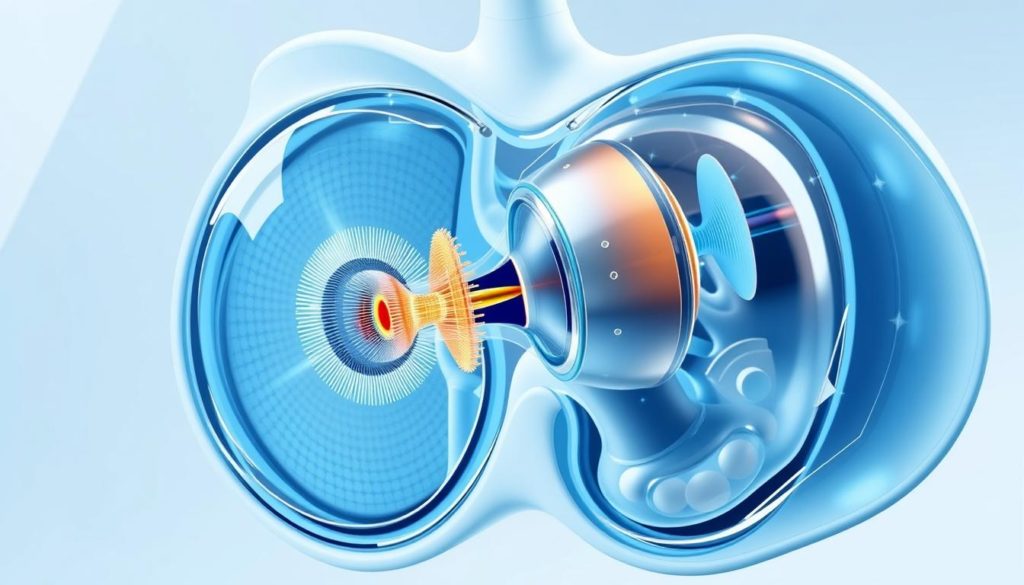Did you know that 1 in 8 men will be diagnosed with prostate cancer in their life? This makes advancements in care very important. Whole-gland ablation is one such advancement, offering new hope to patients.
This therapy targets the whole prostate gland with heat or cold to kill cancer cells. It’s less invasive than traditional treatments, leading to a quicker recovery and fewer side effects. It suits those with early-stage prostate cancer or those who wish to avoid big surgeries.
Getting to know about whole-gland ablation can give people facing prostate cancer more options for their care. Are you ready to learn more? Let’s look into how this therapy works and how it could help patients.
Introduction to Whole-Gland Ablation for Prostate Cancer
Whole-gland ablation is a new way to fight early-stage prostate cancer. It offers different surgery options than the usual ones. It’s a less invasive method focusing on removing cancer cells and saving healthy tissue.

Overview of Prostate Cancer Treatment Options
There are many ways to treat prostate cancer, from traditional surgeries to newer, less harsh methods. Patients can pick from watching the cancer closely, undergoing surgery, or getting radiation. Each choice affects their life differently. Whole-gland ablation is a precise and less harmful option.
Definition and Purpose of Whole-Gland Ablation
Whole-gland ablation destroys the whole prostate to kill cancer cells. It uses heat or cold to remove the bad tissue but keeps the good. This method aims to lessen side effects from other surgeries. It helps patients stay healthier and live better after treatment.
How Whole-Gland Ablation Works
Whole-gland ablation is a cutting-edge method that tackles prostate cancer by targeting the entire gland. It uses advanced techniques with heat and cold. The aim is to get rid of the cancer cells.
Techniques Used: Heat and Cold
There are two main techniques in this process.
- Cryotherapy uses very cold temperatures to freeze and kill the cancer cells. A probe is put through the perineum and is guided by ultrasound for accurate targeting.
- High-Intensity Focused Ultrasound (HIFU) creates high heat with sound waves to destroy the cancer cells. A probe is placed into the rectum, and ultrasound helps ensure it’s accurate.
Procedural Steps
The steps for whole-gland ablation are carefully planned for best results.
- A probe is inserted, guided by ultrasound, either through the rectum (HIFU) or perineum (cryotherapy).
- The temperature is watched and adjusted for the best outcome of tissue ablation.
- Patients usually stay in the hospital overnight. Then, they have a short catheterization period to help with swelling and urine flow.

| Technique | Method | Guidance | Follow-Up |
|---|---|---|---|
| Cryotherapy | Cold Temperatures | Ultrasound Imaging | Overnight Stay, Short Catheterization |
| HIFU | Intense Heat | Ultrasound Imaging | Overnight Stay, Short Catheterization |
The Benefits of Whole-Gland Ablation
Whole-gland ablation offers a minimally invasive approach to managing prostate cancer. It does not require cuts or stitches. This lets patients get back to their daily lives quicker than with traditional surgery.
Minimally Invasive Nature
This method is a standout in minimally invasive prostate treatments. It cuts down the need for major surgery. Patients often recover faster and face fewer issues. This is why both doctors and patients prefer it.
Reduced Side Effects
Whole-gland ablation lessens sexual and urinary side effects. Traditional surgeries can have lasting negative effects. But, whole-gland ablation aims to lower these risks. It ensures a better recovery. Studies show it matches radical surgery in effectiveness, with less invasiveness.
Differences Between Whole-Gland and Partial-Gland Ablation
We see key differences when we look at whole-gland and partial-gland ablation. Whole-gland ablation goes after the entire prostate. On the other hand, partial-gland or focal therapy targets only the cancer areas. These methods aim to make prostate cancer treatment better. They try to lessen side effects while keeping life quality high.
Whole-gland ablation usually takes longer and has a longer recovery time. This might mean more side effects than partial-gland ablation. Choosing between whole or partial-gland ablation depends on the cancer stage and personal health. This personalized approach makes sure patients get the best and most fitting prostate cancer treatment.
| Ablation Type | Target Area | Procedure Duration | Recovery Time | Potential Side Effects |
|---|---|---|---|---|
| Whole-Gland Ablation | Entire Prostate | Longer | Extended | Higher |
| Partial-Gland Ablation | Specific Cancer Areas | Shorter | Shorter | Lower |
In short, knowing the differences between these prostate cancer surgeries helps. It helps in making choices that fit each patient’s needs. This improves how effective prostate cancer therapy is.
Who is a Candidate for Whole-Gland Ablation
Whole-gland ablation is a treatment for prostate cancer. It’s good for those looking at prostate cancer treatments. It’s best for patients with low-risk, early-stage cancer. If the cancer has not spread, this might be a good choice.
Criteria for Eligibility
To be eligible for whole-gland ablation, patients must meet specific conditions. They should have early-stage prostate cancer. Their Gleason score should be below 8. Also, their PSA score must be under 20. Importantly, there should be no cancer spread.
Meeting these conditions helps ensure the treatment works well. It also helps reduce risks and improve recovery.
When Whole-Gland Ablation is Preferred
Whole-gland ablation is ideal in certain cases. For example, when prostate cancer does not respond to radiation. Or, if the cancer comes back after radiation therapy. It’s a less invasive option.
It causes fewer sexual and urinary side effects. Research shows it might be a great choice for African-American men. This method is less invasive and promising.
This treatment is a good choice for those seeking effective therapy. It balances managing cancer and improving life quality.
Comparing Whole-Gland Ablation with Traditional Surgery
Looking at prostate cancer care is important. We need to compare whole-gland ablation and traditional surgery. This helps us see how they differ and what they mean for patient outcomes.
Recovery Time
Whole-gland ablation has a big plus over traditional surgery. Its recovery time is much shorter. Patients can often get back to their normal activities in just a few days after the procedure.
In contrast, traditional surgeries require a long recovery time. During this time, patients must be very careful to heal properly.
Effectiveness and Survival Rates
For those with low-risk prostate cancer, whole-gland ablation is just as effective as surgery. Studies show that survival rates five years after the procedure are similar. This makes it a less invasive option.
Yet, it’s important to remember. For high-risk prostate cancers, traditional surgery and radiation are better. They provide the most thorough care for prostate cancer.
Risks and Side Effects of Whole-Gland Ablation
Whole-gland ablation is an option for treating prostate cancer. It’s vital to know the risks involved. Patients might feel pain or a burning sensation when peeing, face urinary problems, have trouble with erections, see bruising, and feel the need to urinate more often. Yet, these issues usually go away a few weeks after the treatment.
Common Side Effects
After whole-gland ablation, some side effects are common:
- Pain or burning during urination
- Urinary incontinence
- Erectile difficulties
- Bruising
- Increased urgency to urinate
These side effects are mostly short-term. Knowing and preparing for them can help manage expectations after the procedure.
Managing Post-Procedure Pain and Discomfort
It’s key to handle the side effects of prostate treatment for better comfort and recovery. Doctors may prescribe pain relievers or suggest care tips to lessen symptoms. They might also recommend a urinary catheter temporarily for swelling and to ensure urine flows well. Following these advice can ease discomfort and help with a smoother recovery.
Whole-Gland Ablation Prostate Cancer
Whole-gland ablation is a special type of prostate cancer treatment. It’s not as invasive as traditional surgery, making it attractive for many. It’s especially good for early-stage prostate cancer patients because it may lead to fewer side effects after treatment.
This technique uses either intense heat or cold to kill off prostate tissue. It’s a gentler option compared to harsher treatments, aiming to keep the patient’s life quality high. This approach targets the tumor while trying to dodge the major issues that come with completely removing the prostate.
For patients looking beyond traditional surgery, whole-gland ablation could be what they’re seeking. It’s key to talk about this prostate cancer therapy option with a doctor, as it’s not for everybody. The cancer’s stage and the patient’s overall health are crucial in picking the right treatment.
Compared to other surgical options, whole-gland ablation might lead to fewer issues with sexual and urinary functions. However, potential side effects like urination pain, incontinence, or erectile dysfunction can’t be ignored. Consulting with healthcare experts thoroughly is vital to choose the most suitable therapy.
| Criterion | Whole-Gland Ablation | Traditional Surgery |
|---|---|---|
| Invasiveness | Minimally Invasive | Highly Invasive |
| Recovery Time | Shorter | Longer |
| Sexual Side Effects | Potentially Fewer | More Common |
| Urinary Side Effects | Potentially Fewer | More Common |
In conclusion, whole-gland ablation stands out for those seeking an effective prostate cancer treatment with fewer lasting side effects. The most important step is having detailed discussions with healthcare professionals. This ensures that the treatment fits well with personal health objectives and conditions.
Advancements in Whole-Gland Ablation Technology
In recent years, the progress in prostate cancer treatment has been significant. Advances in whole-gland ablation technology stand out. They’re making this treatment safer, more precise, and effective.
This progress is thanks to new techniques and better equipment. It’s changing the game for people with advanced prostate cancer.
Latest Techniques and Equipment
New methods like updated cryotherapy and high-intensity focused ultrasound (HIFU) are now used. Cryotherapy freezes and kills the cancer cells. HIFU uses sound waves to heat and destroy tumors.
The use of real-time imaging improves the accuracy of these procedures. It lowers the risks and leads to better results for patients.
Advancements in prostate cancer treatment highlight the importance of precise image-guided focal therapies. According to recent research, utilizing real-time imaging during ablation procedures ensures better targeting and minimizes damage to surrounding healthy tissues.
Future Prospects
The outlook for treating advanced prostate cancer is bright. New developments in whole-gland ablation technology are underway. These efforts will make treatments even more tailored and specific to each patient.
This personalized approach could improve how effective treatments are and the patient’s outcome. New technologies are on the horizon. They promise even more accurate, effective, and gentler options for patients in the future.
Post-Treatment Care and Monitoring
After treating prostate cancer, post-treatment care is key. It helps in watching recovery and stops the disease from coming back. It’s all about keeping a close eye on your prostate health.
Follow-Up Appointments
Follow-up appointments are very important for prostate cancer care. They include regular PSA tests to check for cancer signs. Imaging and exams also help look at healing and the prostate’s state. Going to all appointments helps catch and treat any problems early.
Maintaining Prostate Health
Healthy living is part of post-treatment care too. Eating well and exercising help your body and prostate. By following your doctor’s advice and living healthy, you can improve your recovery and health for the future.
FAQ
What is Whole-Gland Ablation for prostate cancer?
Whole-Gland Ablation is a minimally invasive way to treat early-stage prostate cancer. It uses techniques like heat (HIFU) or cold (cryotherapy) to destroy the entire prostate gland. This kills cancer cells while saving the healthy tissue around it.
Who is an ideal candidate for Whole-Gland Ablation?
People with low-risk, early-stage prostate cancer are good candidates. They should have a Gleason score lower than 8 and a PSA score under 20.
How does Whole-Gland Ablation work?
The procedure targets and kills prostate cancer cells with heat or cold. Small probes are used, guided by ultrasound for accurate treatment.
What are the benefits of Whole-Gland Ablation compared to traditional treatments?
It’s less invasive, requires no cuts, and you can quickly get back to your life. It causes fewer problems with sex and peeing. It’s also just as effective for certain prostate cancers.
How does Whole-Gland Ablation differ from Partial-Gland Ablation?
Whole-Gland Ablation removes the entire prostate, while Partial-Gland Ablation only targets the cancerous parts. This may mean more time for the procedure, recovery, and possible side effects.
What are the potential side effects of Whole-Gland Ablation?
Some people may feel pain or burning when peeing, have trouble holding pee, experience erectile difficulties, get bruised, or pee more often. Usually, these issues get better within weeks after the procedure.
What does the recovery process look like after Whole-Gland Ablation?
Patients often stay in the hospital overnight and may need to use a catheter for a short time. They can go back to most activities within days, faster than after surgery.
How effective is Whole-Gland Ablation in treating prostate cancer?
For low-risk prostate cancer, it works as well as surgery but with fewer side effects and quicker recovery.
What advancements have been made in Whole-Gland Ablation technology?
The technology has gotten better, safer, and more precise. New cryotherapy and HIFU, along with better imaging, make it more effective and reduce risks.
What follow-up care is necessary after Whole-Gland Ablation?
Patients need regular PSA tests, imaging, and exams to check for cancer’s return. Eating well and exercising help with recovery and keeping the prostate healthy.


